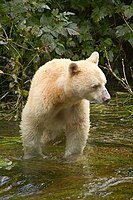
Photo from wikipedia
One of the most distinctive colour polymorphisms of any mammal occurs in black bears (Ursus americanus kermodei Hornaday) of the Great Bear Rainforest of coastal British Columbia. We use carbon… Click to show full abstract
One of the most distinctive colour polymorphisms of any mammal occurs in black bears (Ursus americanus kermodei Hornaday) of the Great Bear Rainforest of coastal British Columbia. We use carbon and nitrogen stable isotope values and C/N ratios along segments of hair shafts obtained from 14 white and 12 black individual bears to quantify dietary niche of the morphs as a test of the multi-niche model for a polymorphism. On Gribbell Island, where the white bear reaches 30%, 15N is significantly (GLM repeated measures) more enriched (more marine-derived nitrogen) in the white morph than in the black morph in each season (spring, summer, autumn). On the adjacent Princess Royal Island, where the white morph is less common, both morphs are highly enriched during autumn (~δ15N = +11‰), but there are no isotopic differences between morphs in any season. On both islands, C/N ratios (~3.1) of the black morph decrease from spring to autumn, converging on the lower average values for the white morph. Our data suggest that niche of the white morph involves increased use of a marine-associated diet and that ecological segregation between the morphs has facilitated the historical persistence of the polymorphism.
Journal Title: Biological Journal of The Linnean Society
Year Published: 2017
Link to full text (if available)
Share on Social Media: Sign Up to like & get
recommendations!